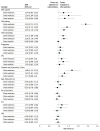Association of HIV Intervention Uptake With HIV Prevalence in Adolescent Girls and Young Women in South Africa
- PMID: 35452103
- PMCID: PMC9034400
- DOI: 10.1001/jamanetworkopen.2022.8640
Association of HIV Intervention Uptake With HIV Prevalence in Adolescent Girls and Young Women in South Africa
Abstract
Importance: In South Africa, adolescent girls and young women aged 15 to 24 years are among the most high-risk groups for acquiring HIV. Progress in reducing HIV incidence in this population has been slow.
Objective: To describe HIV prevalence and HIV risk behaviors among a sample of adolescent girls and young women and to model the association between exposure to multiple or layered interventions and key HIV biological and behavioral outcomes.
Design, setting, and participants: This cross-sectional survey was conducted between March 13, 2017, and June 22, 2018, in 2 districts in Gauteng province and in 2 districts in KwaZulu-Natal province in South Africa. A stratified cluster random sampling method was used. Participants included adolescent girls and young women aged 12 to 24 years who lived in each sampled household. Overall, 10 384 participants were enrolled in Gauteng province and 7912 in KwaZulu-Natal province. One parent or caregiver was interviewed in each household. Data analysis was performed from March 12, 2021, to March 1, 2022.
Exposures: DREAMS (Determined, Resilient, Empowered, AIDS-free, Mentored, and Safe)-like interventions.
Main outcomes and measures: The primary outcome was HIV prevalence. HIV status was obtained from laboratory-based testing of peripheral blood samples. Secondary outcomes included HIV testing and antiretroviral therapy uptake as well as numerous HIV risk variables that the DREAMS program sought to improve, such as pregnancy, sexually transmitted infection, intimate partner violence, and age-disparate sex.
Results: The final sample included 18 296 adolescent girls and young women (median [IQR] age, 19 [15-21] years) in 10 642 households. Approximately half of participants (49.9%; n = 8414) reported engaging in sexual activity, and 48.1% (n = 3946) reported condom use at the most recent sexual encounter. KwaZulu-Natal province had a higher HIV prevalence than Gauteng province (15.1% vs 7.8%; P < .001). Approximately one-fifth of participants (17.6%; n = 3291) were not exposed to any interventions, whereas 43.7% (n = 8144) were exposed to 3 or more interventions. There was no association between exposure to DREAMS-like interventions and HIV status. Adolescent girls and young women who accessed 3 or more interventions were more likely to have undergone HIV testing (adjusted odds ratio, 2.39; 95% CI, 2.11-2.71; P < .001) and to have used condoms consistently in the previous 12 months (adjusted odds ratio, 1.68; 95% CI, 1.33-2.12; P < .001) than those who were not exposed to any interventions.
Conclusions and relevance: Results of this study suggest that self-reported exposures to multiple or layered DREAMS-like interventions were associated with favorable behavioral outcomes. The beneficial aspects of layering HIV interventions warrant further research to support the sexual and reproductive health of adolescent girls and young women.
Conflict of interest statement
Figures


References
-
- UNAIDS . South Africa: new HIV infections. 2018. Accessed October 27, 2020. https://aidsinfo.unaids.org/
-
- Simbayi L, Zuma K, Zungu N, et al. . South African National HIV Prevalence, Incidence, Behaviour and Communication Survey, 2017: Towards Achieving the UNAIDS 90-90-90 Targets. HSRC Press; 2019.
-
- Cowden RG, Tucker LA, Govender K. Conceptual pathways to HIV risk in Eastern and Southern Africa: an integrative perspective on the development of young people in contexts of social-structural vulnerability. In: Govender K, Poku NK, eds. Preventing HIV Among Young People in Southern and Eastern Africa: Emerging Evidence and Intervention Strategies. Routledge Taylor & Francis Group; 2021:31-47.
Publication types
MeSH terms
LinkOut - more resources
Full Text Sources
Medical

